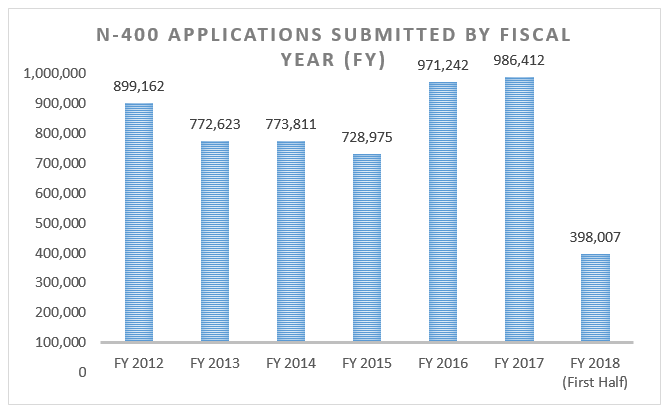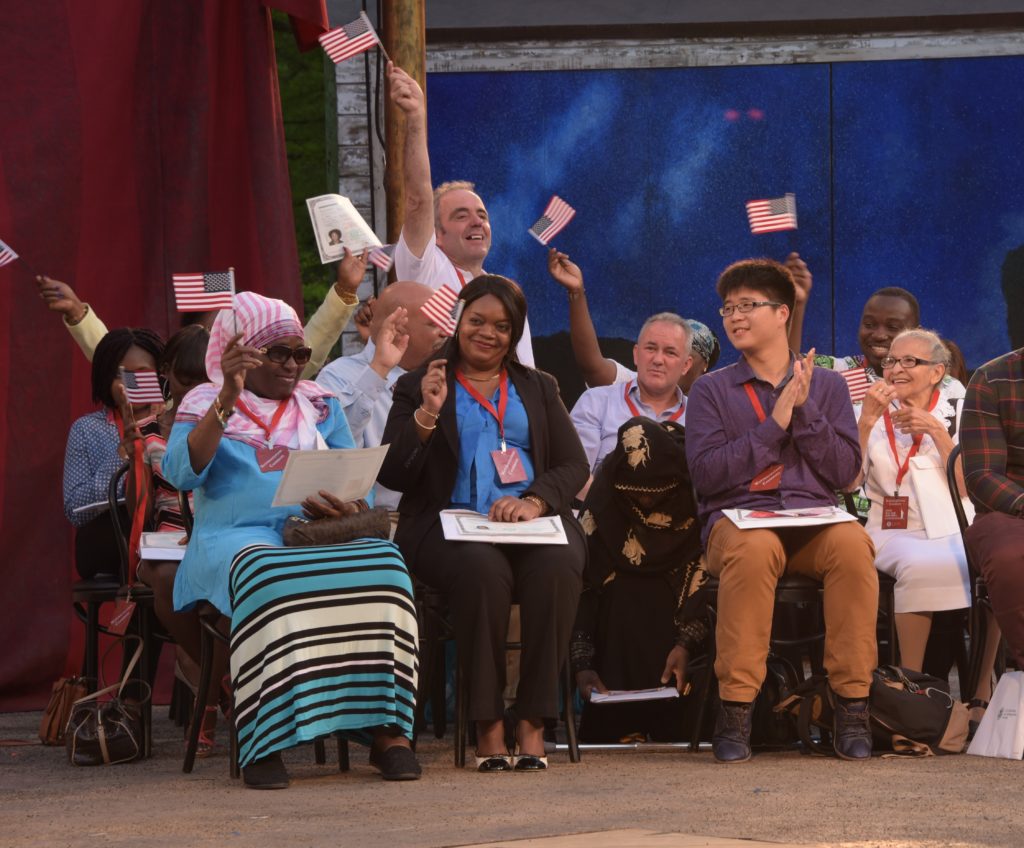Almost one million people filed applications for citizenship in fiscal year (FY) 2017, the highest number since FY 2007 and overall the fourth highest number in American history. This monumental interest in naturalization — a cause to celebrate due to its established economic and societal benefits — met a processing backlog that continues to delay citizenship applications for hundreds of thousands of people. The Trump administration and Congress should address these delays.
A Growing Naturalization Backlog
U.S. Citizenship and Immigration Services (USCIS), the agency responsible for processing the N-400 Application for Naturalization, received 986,000 citizenship applications from lawful permanent residents, also known as “Green Card” holders, in FY 2017 and 398,000 applications in the first six months of FY 2018. Of these, individuals who are serving or served in the military submitted almost 11,000 applications in FY 2017 and 1,730 in the first six months of FY 2018.
At the same time, the number of citizenship applications pending adjudication reached 753,000 by the end of the first six months of FY 2018, a hefty 44 percent increase from about 522,000 pending applications at the end of FY 2016. Average processing times in some USCIS field offices reached 10.2 months in FY 2018, with some applicants waiting up to 20 months, compared to the national average in 2016 that was about 5.6 months. In Houston, Texas, the processing time for a citizenship application in 2018 ranged from 17.5 to 19 months, about triple the state average in 2016, which ranged from five to six months. The USCIS Ombudsman office, which is an independent entity in the Department of Homeland Security (DHS), noted that these prolonged processing times affected the ability of LPRs to “reunite with families, progress in their careers, and fully integrate into the community with all the rights and responsibilities of an American citizen.”

A number of important factors have played a role in the naturalization backlog. First, USCIS is dealing with a higher-than-usual interest in citizenship applications. The amount of naturalization applications submitted in FY 2017 and the first six months of FY 2018 is higher than usual. Historical data indicates that the number of citizenship applications submitted to USCIS generally spikes in an election year, followed by a drop in applications the following year. However, in FY 2017 following the 2016 election, the number of citizenship applications submitted did not go down but increased slightly by 1.5 percent. In comparison, the number of applications submitted in FY 2013 decreased by 14 percent compared to FY 2012.
Next, USCIS did not account for the expected spikes in citizenship applications in FY 2016, discounting the agency’s historical data that applications increase in an election year. Despite the fact it was an election year, USCIS projected it would receive almost 775,000 citizenship applications in FY 2016, below the number of receipts received in FY 2015 and nearly 200,000 less than it actually received that year. The following year, USCIS projected it would receive 853,000 citizenship applications in FY 2017, but received more than 130,000 additional applications than it anticipated. USCIS now projects that it will receive 971,600 citizenship applications in FY 2018 and 913,500 applications in FY 2019, a projection consistent with the higher application numbers in FYs 2016 and 2017,but one that is likely overestimating application numbers for FY 2018 based on the year’s first two quarters.

In addition, history indicated that a naturalization fee increase that went into effect in December 2016 (from $595 to $640 — an eight percent increase) would likely increase the number citizenship applications, as happened almost ten years before. In FY 2007, the last time USCIS proposed an increase to the naturalization fee, citizenship applications increased by 89 percent to 1.4 million compared to the year before.
USCIS’ incorrect projections meant that the agency failed to assign or hire sufficient staffers to process naturalization applications. As the number of citizenship applications submitted to USCIS increased, the naturalization backlog worsened.
USCIS Must Assign Staff to Decrease the Backlog
The Trump administration has an opportunity to reduce the naturalization backlog by ensuring USCIS follows up on its plan to increase the number of staffers in USCIS District Operations, which process citizenship applications. USCIS recently stated its plans to set 8,580 district operation staffers for FY 2019, about 685 more staffers than requested in FY 2018 and 690 more staffers than enacted in FY 2017 (about a 9 percent increase in both cases). It is unclear whether USCIS plans to assign most, if any, of the new district operations staffers to process naturalization applications and whether assigning the entire 685 additional staffers is enough to reduce the naturalization backlog to an average of five months, the agency’s stated goal since at least 2007.
If USCIS does not assign these new staff to address the naturalization backlog, Congress should intervene by passing legislation directing USCIS to assign enough district operations staffers to reduce the naturalization backlog to an average of five months.
Congress Must Enact Policies to Reduce the Backlog
Congress can also help address the problem and enact policies that allow USCIS staff to focus on processing more naturalization applications, while maintaining USCIS’s role in ensuring our national security. Congress should exempt eligible LPRs from the English and civics portion of the naturalization test if they are able to demonstrate that they graduated from a high school after completing academic grades six through 12 in the U.S. and that their curriculum reflects knowledge of U.S. history, government and civics, as well as the English language.
Congress should also expand exemptions from the English and civics portion of the naturalization test for certain elderly applicants, many of whom may be unable to learn a new language or memorize civics facts for a test. Eligible LPRs who are older than 60 and have lived in the U.S. as LPRs for at least 10 years and those older than 65 who have lived in the U.S. as LPRs for at least five years should receive a waiver from the English requirement in the naturalization test. Eligible LPRs who are older than 75 and have lived in the U.S. for at least five years as LPRs should receive a waiver from the civics requirements in the naturalization test.
America Benefits from Naturalization
USCIS and Congress have a responsibility to ensure that the naturalization process is more accessible to eligible immigrants by addressing the backlog. America’s economic and civic health benefit from the efficient and timely processing of naturalization applications, because naturalization provides significant economic benefits to the nation and helps immigrants reach their full potential and contribute fully to their local communities. Making the naturalization process more efficient by assigning more staffers to process naturalization applications, exempting certain LPRs from the English and civics portions of the naturalization test, and expanding certain exemptions for elderly LPRs would go a long way in helping reduce the naturalization backlog to five months, as USCIS committed to doing more than ten years ago. It is time for USCIS to keep its commitment to adjudicate immigration applications efficiently and fairly.



